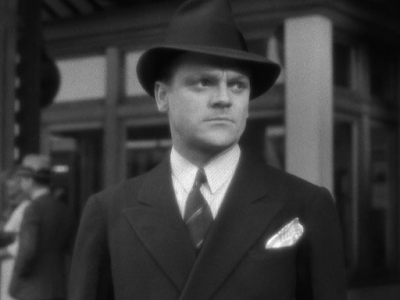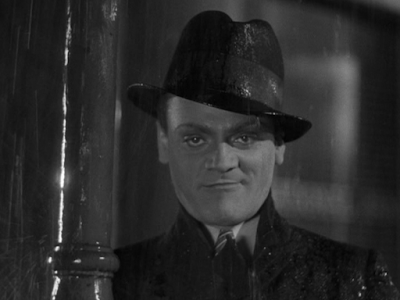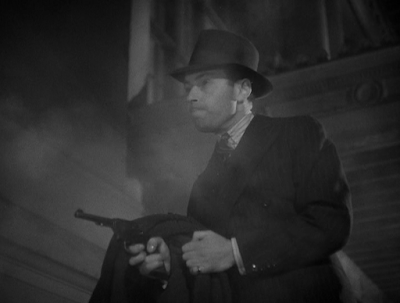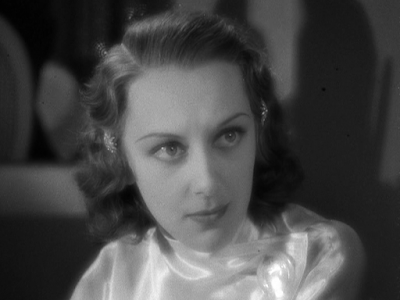 |
| James Cagney in G-Men (1935) |
While I was discussing gangster films with my long suffering partner a couple of nights ago, I asked her to name a famous bank robber off the top of her head. Her response was "Bonnie and Clyde." She could have named John Dillinger, I suppose, or Pretty Boy Floyd, or maybe even D. B. Cooper, but the thing about all of these names is that they are in the past, and all of them have been subsumed into American folklore. There have been countless films about these characters. The lion's share of these people lived during the Great Depression, and one of the reasons that they became famous, became folk anti-heroes of a kind, is because the economic calamity following the Wall Street crash of 1929 undermined the faith in American capitalism. Banks were villains to most folks. For a brief period, the idea that the United States might follow Russia into communism was more than just a leftist fantasy. It's more difficult to name famous bank robbers who worked after the Great Depression, because America successfully engineered a stable capitalist society from the New Deal and demonized bank robbers in films. Apart from D. B. Cooper, who is mostly famous because he was never caught and who remains an enigma, I couldn't name you a bank robber who worked during the last fifty years. Willie Sutton is probably the last great bank robber of the public imagination, mostly because he was famously quoted as robbing banks "Because that's where the money is." It's harder to rob banks these days, and most transactions are electronic anymore, but the twilight of bank robbers as folk heroes happened long before the advent of digital money.
The Motion Picture Production Code administered by Will Hays and Joseph Breen was an instrument of conservative social engineering that touched all aspects of American life. It was used to engineer relationships between men and women in a "morally acceptable" fashion that seems laughable today and which was laughable at the time. It was used to oppress women, force them out of the workforce and into the kinds of unhappy lives dissected by Douglas Sirk in the 1950s. It banned depictions of "miscegenation," and underlined a sea change in how anyone who wasn't white would be depicted going forward. It was used to eradicate even a hint of queerness in society. Actor William Haines--to name one--was driven from the profession because of his sexuality; he opened an interior design business with his partner. Joan Crawford once quipped that they had the happiest, most stable marriage in Hollywood. I think about all of this every time I hear some conservative scold wailing about the immorality of movies these days. There was a societal cost to the Code's prudery, and anyone who wasn't a straight white man paid it. There were some great films made under The Code, sure, mostly in spite of the Code and not because of it. But there were some great movies made before it, too, movies that were mutilated or suppressed by its strictures.
 |
| James Cagney in The Public Enemy (1931) |
One actor The Code actively feared was James Cagney, whose pre-Code persona as a raging gangster or con-artist caused moral scolds to clutch their pearls close to their throats. Even beyond his gangster image, Cagney was known to be a malcontent who had no qualms about confronting the studio when he felt they were trying to screw him. He was steadfastly pro-union. His public image in the early 1930s was as a radical. In spite of this, he was idolized by millions, particularly by young men. The press made noises about the propriety of and the moral lessons taught by Cagney's gangster films. No less a figure than Al Capone himself complained in the papers: "These gang pictures--that's terrible kid stuff. They're doing nothing but harm to the younger element of the country. I don't blame the censors for trying to bar them." Capone, like Will Hays and Joseph Breen, was a good Catholic boy. But the films--particularly The Public Enemy--were a license to print money anyway. When the Catholic League of Decency began pressuring the banks who underwrote the Hollywood studios into enforcing the code, defanging the gangster film and its perceived influence on the teetering social institutions of capitalism was of paramount importance. On this, the banks were of the same mind as the blue-noses. Social order must be restored! The movie studios, on the other hand, wanted the money to continue to flow.
Warner Brothers, the studio where James Cagney made his earliest films, had the bright idea of turning Cagney into a cop. The result, Cagney's 1935 film G-Men (directed by William Keighley), was a huge hit for the studio and was one of the biggest hits of Cagney's career. The film was as violent as any of the gangster films that preceded it, but the Breen Office was satisfied with the change of focus because rather than using that violence to undermine society, Cagney was now exercising the very same violence on behalf of The State. The sheer hypocrisy of the Code toward this film is astonishing; it's among Cagney's most violent films including the pre-Codes, but the target of the violence makes all the difference. Once the returns were in on G-Men, they tried the same thing with Edward G. Robinson in Bullets or Ballots. It worked then, too. It was a big hit and why not? Its story beats were practically verbatim from G-Men.
The phrase "copaganda" is a recent coinage, but the genre more or less begins with G-Men. Before G-Men,
the cop movie didn't really exist as we know it today. The varieties of
mystery story that would become the police procedural were largely in
the future. Detective stories were still generally centered around
gentlemen sleuths like Sherlock Holmes, Hercule Poirot, Nick Charles,
Charlie Chan, or Philo Vance. Cops in these pictures were usually
comedic foils, largely incompetent to capture criminals. In many silent
films and early talkies, particularly those by Charlie Chaplin but also
in Buster Keaton films like "Cops," the policeman is actively the enemy
of the little guy. That was something that was understood by a
population of workers struggling to organize against Capitalism in
unions. Cops in the early 20th Century were mostly strikebreakers to
them. They didn't solve crimes or prevent them. They committed them. The
FBI itself under J. Edgar Hoover was primarily interested in monitoring
communists and racial agitators, though its pursuit of notorious
gangsters put a pleasing coat of paint on it. In all of these cases, to
quote Emma Goldman, "The policeman is the enemy of every working man."
That image changed with G-Men.
The story in G-men follows the career of James "Brick" Davis, a young lawyer who is struggling to make a go of his new practice. Davis came from a rough neighborhood with the rackets going on all around him, but he refuses to take cases from the underworld even though he needs the money. His sponsor through law school was mob boss "Mac" McKay, who asks nothing of him and expresses a desire to get out of the rackets. His best friend, Eddie Buchanan, is a newly minted FBI agent, and suggests to Brick that he might consider becoming a G-man himself. Brick initially brushes him off, but after Buchanan is gunned down in the line of duty, he changes his mind. He says goodbye to the girl who sings at McKay's club, Jean, who pines for him, and has a run-in with McKay's lieutenant, Collins, who schemes to take over McKay's operation. Collins is also the man who killed Buchanan. Brick heads to Washington D.C. to begin his training under the gimlet eye of Jeff McCord, who doesn't much like Brick, especially once Brick takes an interest in his sister, Kay. But Brick perseveres anyway, and when a crushed gardenia is found at the scene of a bank robbery, he recognizes it as the signature affectation of gangster Danny Leggett. It implicates Leggett in Buchanan's murder, too, and Brick volunteers to join the task force assigned to bring him in. His request is denied because he hasn't finished training. His prospects are further impeded when he's spotted visiting Mac on a train where Mac is traveling to his retirement at a hunting lodge in Wisconsin. He's on the outs. Meanwhile, Brick's tip about the gardenia pays dividends and Leggett is captured. Unfortunately for the team that transports him to justice, Collins organizes a hit to spring Leggett. Among the dead federal officers is Brick's one friend at the agency, Hugh Farrell, which rouses Brick to try to right himself at the agency. The massacre also spurs Congress to pass legislation permitting the FBI to arm itself in the face of gangsters with Tommy guns. Soon the war is on, and Brick is in the middle of it in spite of McCord's dislike, though even that begins to thaw when Brick starts to get results.
 |
| Ann Dvorak gets her reward in G-Men (1935) |
There's a lot more plot than is contained in this synopsis. This film is just packed with story. Anything that's not plot is tossed over the side, though that still leaves two romances, a kidnapping, and a training sequence in the mix. Characterization is underlined with quick sketches and a reliance on archetypes. Ann Dvorak's character is a good example, especially when measured against Margaret Lindsey's Kay McCord. Jean (Dvorak) is a singer in a night club and winds up married to the brutal Collins even though she pines for Brick. This role is slotted for her by the lights of the code, which had no time for women who weren't wives and mothers to be. Kay, on the other hand, is from a law enforcement family and is a nurse to boot. She's an upright woman, and thus she must be the woman for Brick in the end. The film dutifully arranges this with Jean's death in the kidnapping plot. I can't help but wonder if this is a judgment visited on the characters Dvorak played in her own pre-code films. She was in Scarface after all, a film as notorious as The Public Enemy. Maybe Warners only had room for one redemption arc in this film. Regardless, Jean is a much more interesting character than Kay and the movie loses something by punishing pre-Code heroines by proxy through her. McCord's primary role is as an obstacle for Brick at the agency and with Kay. Buchanan's role is to die and provide a catalyst for Brick's career. The most interesting character is McKay, who is getting out of the rackets and going straight. Even this can't wash the blood off his hands, and the film dutifully provides him with a version of production code justice even though Brick and the audience both like him. Like Billy Budd in the Melville story, he must be sacrificed to the law.
The character of Brick Davis is an archetype that Warners would reuse every time it wanted to promote one of its gangsters to the side of the angels. He's the tough kid who's been around the rackets. He's alright to the gangsters until something happens to make him turn his back on them. It's as if the studio wasn't sure if the audience would accept Cagney as a copper, and they were hedging their bets. An element of this internal conflict would evolve in the next decade and become subsumed into the moral ambiguity of film noir, but here in the early days, there's no real moral complexity. Brick has a moral compass that's almost simplistic in its views of right and wrong. This too is the production code at work. The Hays office didn't believe in gradations of black and white until the war came along, and even afterward crime must not pay.
J. Edgar Hoover disliked G-Men in 1935, but it was such a big hit that he came around to it at last. When the film was re-released in the late 40s, the studio appended a prologue in which the film was used as a training session for new agents. The FBI was a full participant in the prologue for the film. It was excellent propaganda for the bureau, and excellent disinformation about the bureau's main activities in the post-War years. They refined their desired image as the century wore on, offering their help on The Untouchables and The FBI television shows, and even later on The X-Files--their main demand to the producers of all of these shows was that they not show the bureau in a bad light. The heroes of these shows (particularly Elliot Ness) were often paragons of virtue. The creators of these shows, and other movies and shows to boot, usually complied with the bureau's demands. The whitewash has mostly been successful.
G-Men's influence as a propaganda film extends through other kinds of propaganda throughout the war years and beyond. The ideal was to make an exciting picture that mostly hides its political agenda, and even the most gung-ho flag-wavers were entertainments first and foremost. The archetype of the virtuous hoodlum who joins the side of the angels that this film pioneered carries through those film (in, for example, Humphrey Bogart's entourage in All Through the Night in 1942). It's an archetype so pervasive that it gets a good ribbing fifty years later in The Rocketeer (1991). In this framing gangsters are red-blooded Americans first, hoodlums second. These kinds of characters populate war films into the 1960s, where they reach a kind of reductio ad absurdum in Robert Aldrich's The Dirty Dozen (1967).
While I may sound critical of G-Men's ultimate mission, I won't deny that it's a crackerjack entertainment. Certainly, it's influence wouldn't be as pervasive as it is if it were not a crowd-pleaser. Cagney is in peak form and he's surrounded by a murderer's row of "that guy!" character actors like Robert Armstrong, Lloyd Nolan, and Barton McLane. The filmmakers move the story along at a ferocious clip. It's so fast that even a thoughtful audience won't have time to think about its place in the broader socio-political continuum. It's a film that creates a world of chaos and reassures an uneasy audience that the forces of good will beat back that chaos and restore peace and order. The hero even gets the (virtuous good) girl at the end. All is well with the world. Brick Davis hasn't even a hint of moral ambiguity about him in spite of the film persona of the actor who plays him. Nor does the film question what kind of order the g-man represents. That's a conversation that has taken many a dark turn in the decades since. It's still ongoing today.

This blog is supported on Patreon by wonderful subscribers. If you like what I do, please consider pledging your own support. It means the world to me.






Wonderful background on the moral panic that ushered in the Hays code, using G-Man as an example. Loved the quote from Al Capone who was so worried about the effects of gangster films on the impressionable youth of America! Of course, Al and J. Edgar were brothers in spirit. "Copaganda" (somehow I hadn't run across that term until now) is currently in an expansion phase, with practically every scripted show on network TV sporting some sort of government law enforcement acronym - FBI, NCIS, CSI. Of course, the shows completely ignore the overreach and frequent brutality of these gov't agencies.
ReplyDelete